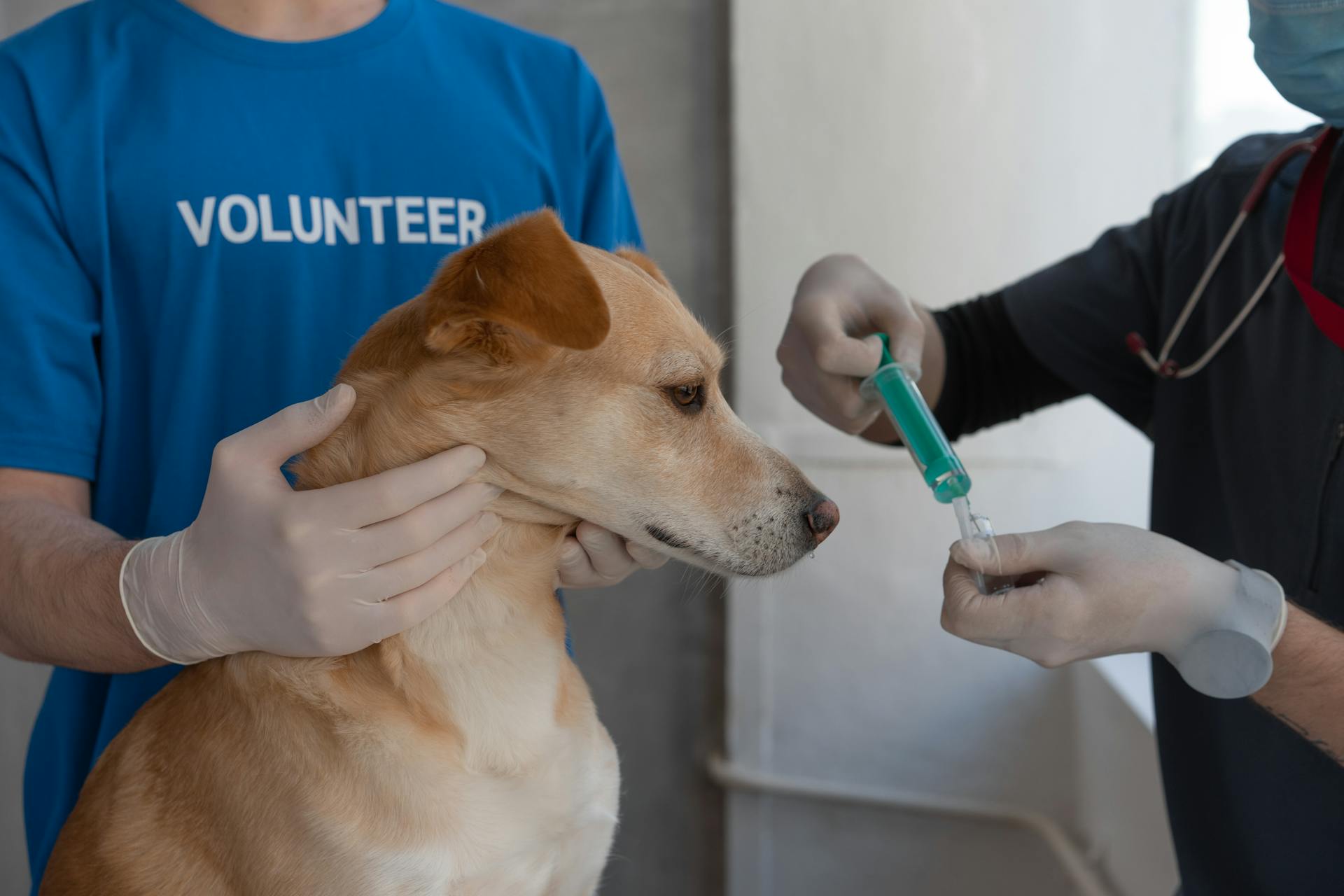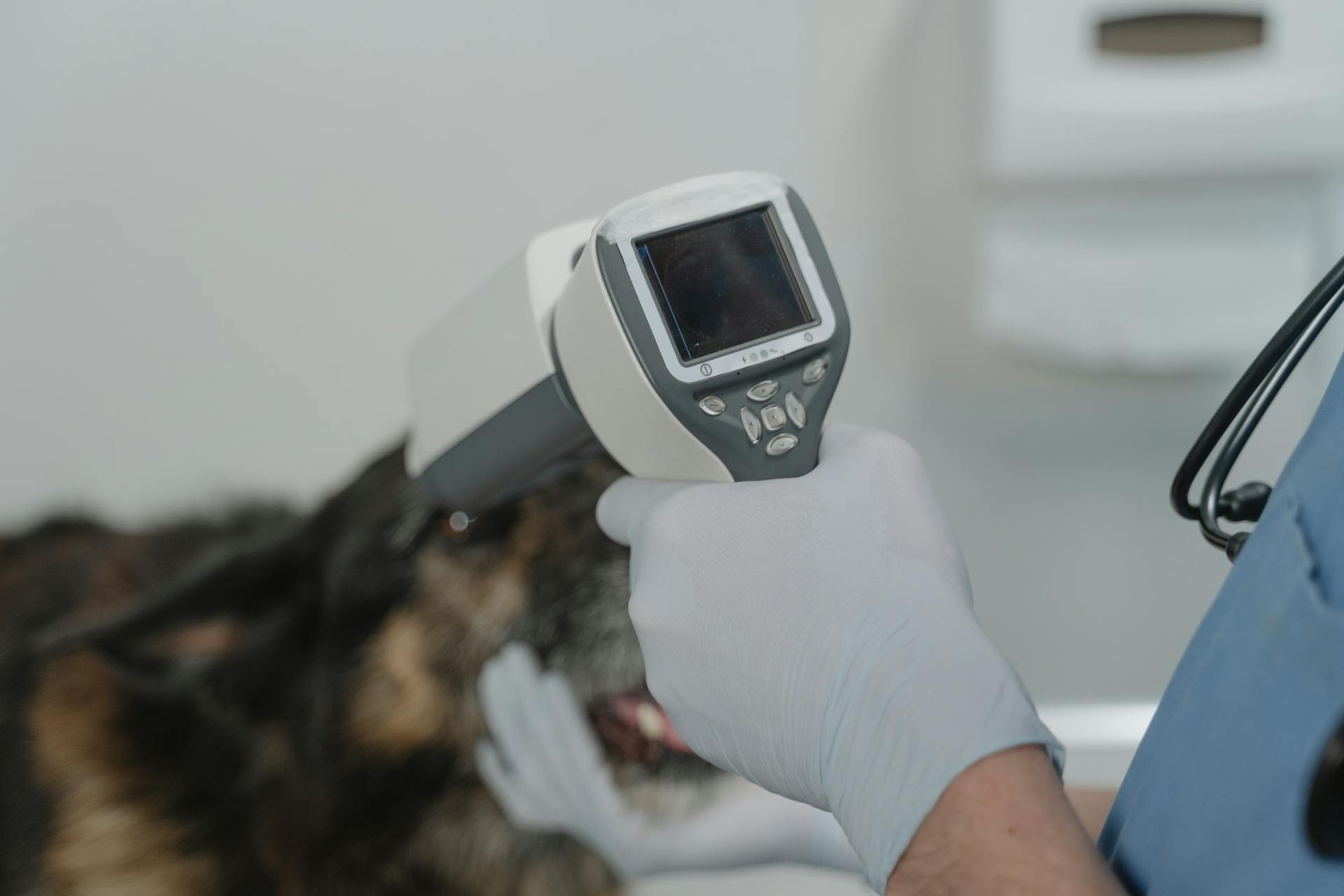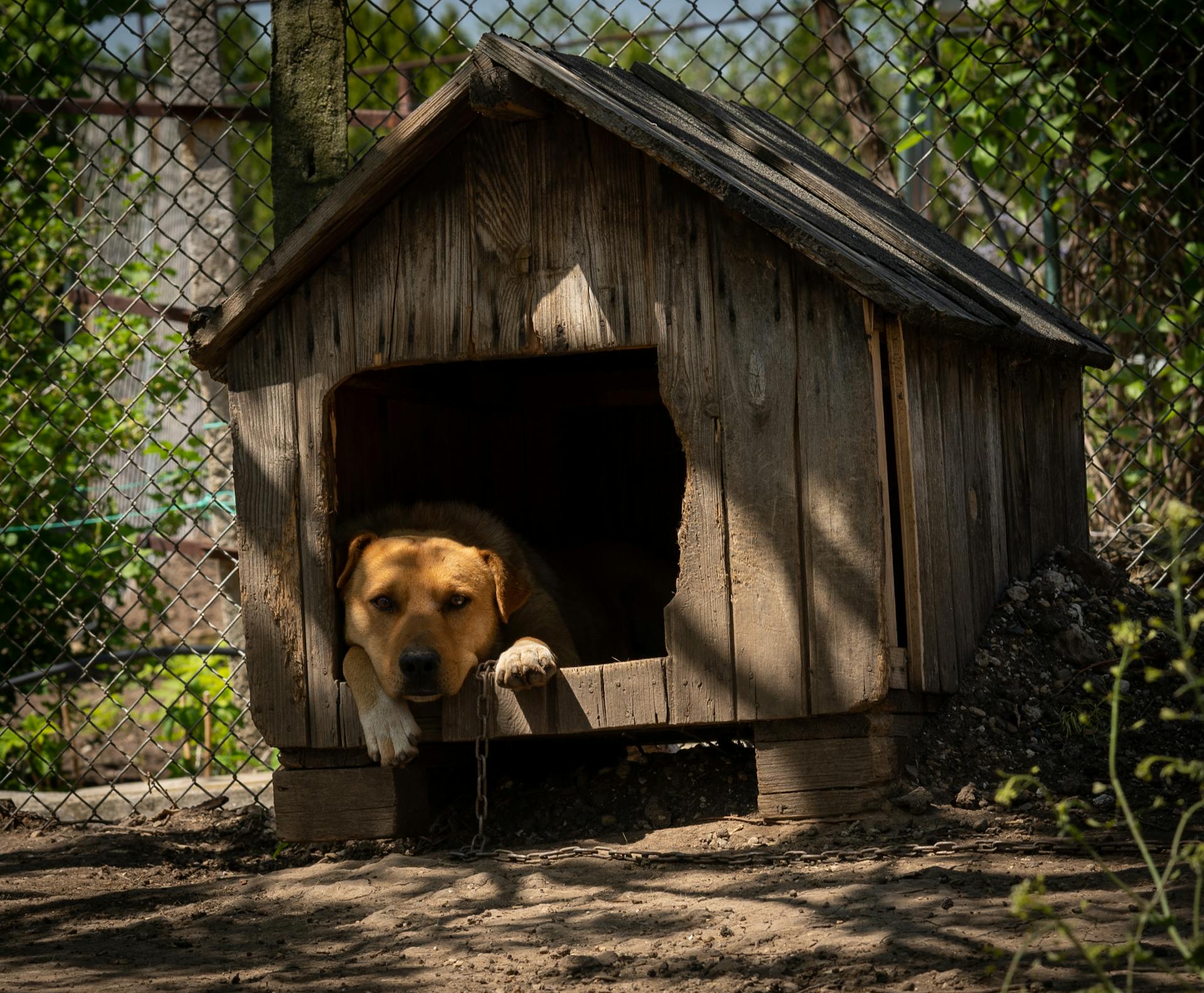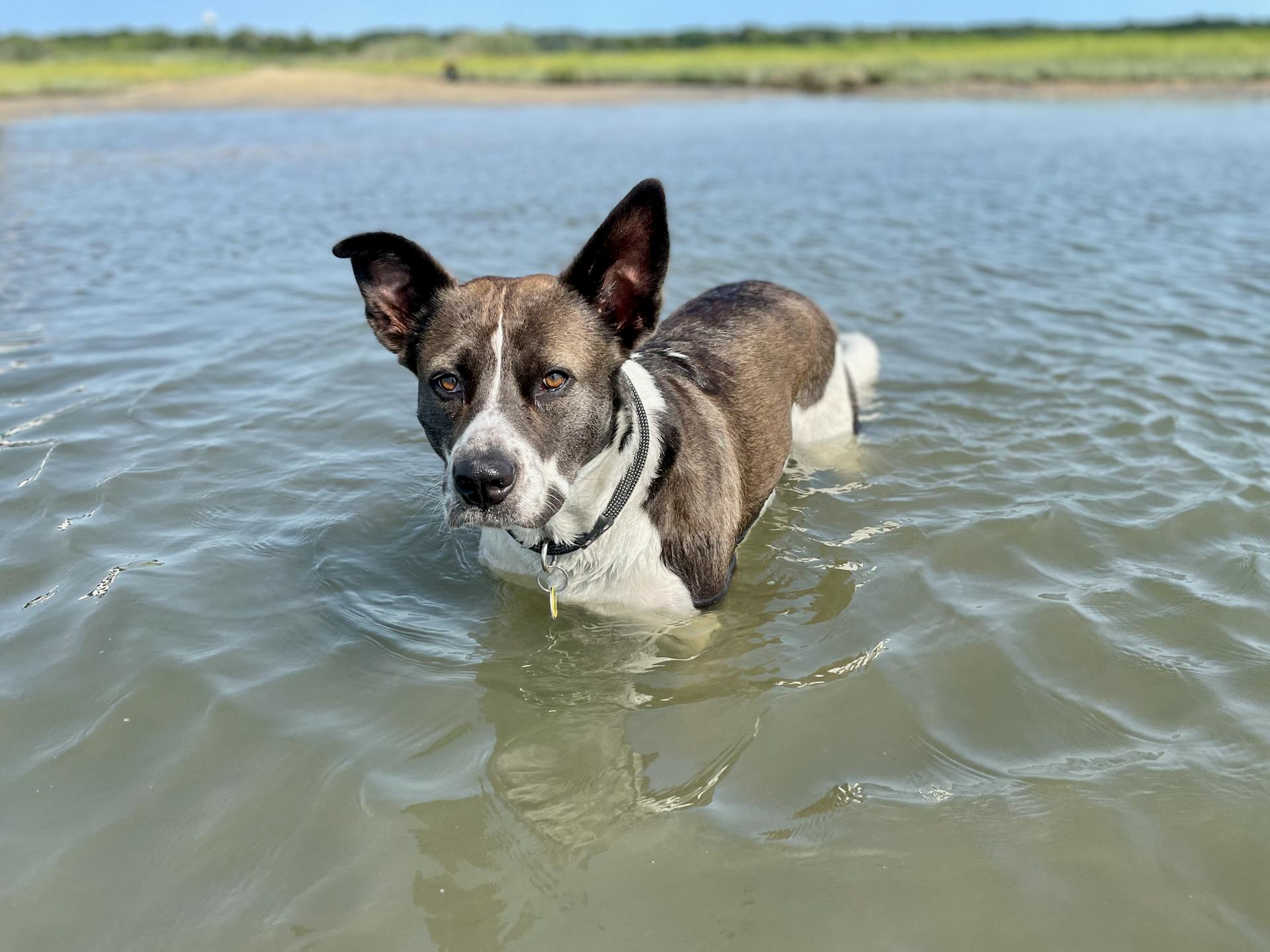
Canine parvovirus is a highly contagious and often fatal disease that affects dogs worldwide. It's caused by a virus that attacks a dog's gastrointestinal system.
The virus is highly contagious and can be spread through contact with an infected dog's feces, vomit, or saliva. This can happen when a dog comes into contact with contaminated surfaces, people, or other animals.
Dogs that are not vaccinated are most susceptible to the virus, and puppies are particularly vulnerable. In fact, puppies under six months old are at the highest risk of contracting parvovirus.
Intriguing read: Canine Distemper Symptoms in Puppies
What is CPV?
Canine parvovirus, or CPV, is a highly contagious and often fatal disease that affects dogs worldwide. It's a significant pathogen that's been spreading globally since its emergence in 1978.
CPV-2 is the causative agent of acute hemorrhagic enteritis and myocarditis in dogs, with a high morbidity rate of 100% and frequent mortality up to 10% in adult dogs and 91% in pups. The disease is characterized by two prominent clinical forms: enteritis with vomiting and diarrhea in dogs of all ages, and myocarditis and subsequent heart failure in pups less than 3 months old.
A different take: Autoimmune Disease in German Shepherds
CPV-2 has spread to various parts of the world, including Asia, Australia, New Zealand, the Americas, and Europe. It's believed to have originated from feline panleucopenia virus (FPV) through a direct mutation or adaptation to the new host dog via non-domestic carnivores like mink and foxes.
The virus was named CPV-2 to differentiate it from a closely related parvovirus of canine known as CPV-1 or minute virus of canine (MVC). MVC is a completely different parvovirus that may cause pneumonia, myocarditis, and enteritis in young pups or transplacental infections in pregnant dams.
Here's an interesting read: Canine Parvovirus 2 Life Cycle
Transmission and Spread
Canine parvovirus is a highly contagious virus that affects dogs, and it's essential to understand how it's transmitted and spreads.
The virus is primarily spread through oral contact with infected feces or contaminated surfaces, such as soil, shoes, dog toys, and cages. It can also survive in feces-contaminated ground for 5 months or more.
Dogs can get exposed to the virus by ingesting it, which is shed in the feces of infected dogs up to two weeks before any symptoms develop, and two weeks after the signs resolve. The virus is hardy and can survive in the environment for up to a year.
Additional reading: How Is Canine Distemper Transmitted
To reduce the risk of transmission, it's crucial to maintain good hygiene and follow proper disinfection practices. This includes thoroughly cleaning and disinfecting any areas where an infected dog has been, using products capable of killing the virus.
Here are some key facts about the transmission and spread of canine parvovirus:
- Infected dogs can shed the virus in their feces for up to two weeks before symptoms appear and two weeks after symptoms resolve.
- The virus can survive in feces-contaminated ground for 5 months or more.
- The virus can survive in the environment for up to a year.
- Proper disinfection practices are essential to reduce the risk of transmission.
Causes of
Parvovirus can survive indoors for up to a month, making it a persistent threat to your pet's health.
Exposure to a dog's waste is a common cause of parvovirus, as dogs can be infectious even before they show symptoms.
Dogs can be contagious with parvovirus for up to a year, which is why it's essential to be cautious when taking your puppy to public spaces.
Parvovirus can live in soil for as long as a year, so if a dog with parvo visited a public space recently, your puppy could contract the disease there.
It's recommended that puppy owners don't take their new pets out in public until they get all four vaccinations and build up their immunity.
Puppies and adolescent dogs are especially susceptible to parvovirus, making them more vulnerable to infection.
The virus can be found in almost any environment, but not every dog who comes into contact with it becomes infected.
How is it Spread?
Canine parvovirus is a highly contagious virus that affects dogs, and it's essential to understand how it's spread to protect your furry friend. The virus can survive in the environment for a long time, up to a year in soil and a month indoors.
It's primarily spread through direct contact with infected dogs, their feces, or contaminated surfaces. These surfaces can include kennels, food and water bowls, collars and leashes, and even the hands and clothing of people who handle infected dogs.
The virus is resistant to heat, cold, humidity, and drying, making it easy to spread through contact with infected feces, even in small amounts. This is why proper disinfection practices are crucial to prevent the spread of the virus.
To minimize the risk of infection, it's recommended to keep your dog away from other dogs when they're sick, including other dogs within your home. You should also avoid contact with known infected dogs and their premises, as well as their feces.
For your interest: How Is Kennel Cough Spread
Here are some additional ways to prevent the spread of canine parvovirus:
- Use caution when bringing puppies to places where dogs gather, such as pet shops, parks, puppy and obedience classes, doggy day cares, kennels, and groomers.
- Choose establishments and training programs that require up-to-date vaccinations, health examinations, good hygiene, and isolation of sick puppies and dogs.
- Routinely collect and properly dispose of your dog's feces.
- If you've been in contact with dogs with or exposed to parvovirus, avoid handling other dogs, or wash your hands and change your clothes before doing so.
Symptoms and Diagnosis
Symptoms of canine parvovirus can be quite distressing for both dogs and their owners. Dogs with enteritis act like they are in extreme pain, and early symptoms include depression, loss of appetite, vomiting, high fever, and severe diarrhea.
Diarrhea can appear in dogs of any age, but it's most common in puppies between the time of weaning and 6 months old. The stool may be watery, yellow in color, or tinged with frank blood in severe cases.
Rapid dehydration is a significant danger, and dogs may continue to vomit and have diarrhea until they die, usually 3 days after the onset of symptoms. Puppies can die suddenly of shock as early as 2 days into the illness.
A presumptive diagnosis of CPV enteritis can be made based on clinical signs such as depression, vomiting, diarrhea, anorexia, and fever. Your veterinarian will likely recommend blood work to check for anemia or low blood sugar levels.
Readers also liked: Blood Sugar Levels for Dogs with Diabetes
A fecal testing can confirm the diagnosis, and a fecal ELISA test is a common and convenient method of testing for the presence of CPV. This test can usually be completed by your veterinarian in less than 15 minutes.
A simple measure of white blood cell count is often the clincher for a CPV diagnosis, as parvovirus infects the bone marrow, leading to a low white blood cell count.
For more insights, see: Canine Distemper Test
Tests and Diagnosis
A presumptive diagnosis of canine parvovirus (CPV) enteritis can be made based on clinical signs such as depression, vomiting, diarrhea, anorexia, and fever.
Veterinarians may suspect parvovirus infection based on the signs your dog is showing, your dog's history, and other factors.
The most common method of testing for CPV is the fecal ELISA test, which can usually be completed by your veterinarian in less than 15 minutes.
ELISA tests are relatively quick and inexpensive, and can be performed in any veterinary clinic.
Discover more: Diabetes and Dogs

However, ELISA tests can occasionally produce false positive or false negative results, so further testing may be necessary to confirm a diagnosis.
A low white blood cell count can be suggestive of CPV infection, as the parvovirus infects the bone marrow.
The Loop Mediated Isothermal Amplification of DNA (LAMP) method can be used to detect CPV genomic DNA in fecal samples, with a relative sensitivity of 100% and a relative specificity of 76.9%.
A fecal sample is added to the ELISA test chamber, and antibodies attach to parvovirus proteins that may be present in the stool, causing a color-changing chemical to indicate a "positive" result.
The CPV fecal PCR test detects small pieces of viral DNA that are specific to CPV in the stool of an infected dog, and is very accurate.
The detection limit of the LAMP method is 10 median tissue culture infective doses (TCID50)/ml.
Fecal testing can confirm the diagnosis of CPV, and is a relatively quick and inexpensive test.
For your interest: Canine Parvovirus Test
Symptoms and Complications

Symptoms of parvovirus can be quite subtle at first, often starting with unexpected tiredness or lethargy. Your dog may lose their appetite as the virus attacks their small intestine lining.
A sudden fever is a common symptom, followed by diarrhea and vomiting. If your dog is experiencing bouts of bloody diarrhea and/or vomiting, parvovirus is only one of several potential culprits.
Dogs with parvovirus often exhibit lethargy, depression, and loss or lack of appetite. These symptoms can progress to a high fever, vomiting, and diarrhea.
Puppies are particularly vulnerable to parvovirus, with most cases occurring between the time of weaning and 6 months of age.
Discover more: Does Kennel Cough Cause Vomiting
Isolation of CPV
Isolation of CPV is crucial for understanding the virus and developing a treatment. Primary cell cultures like MDCK and CRFK support replication of CPV.
Researchers have successfully isolated CPV from cases of myocarditis and enteritis using these cell cultures. This allows for the biochemical and molecular characterization of the virus.
A-72, a canine cell line, has proven particularly useful for CPV isolation from field materials. It has a fibroblastic appearance and can maintain its characteristics for over 135 serial passages.
Plaques produced by CPV under methyl cellulose or agarose overlay media vary in size, ranging from 0.4 to 1.5 mm in diameter.
Frequently Asked Questions
Can humans catch canine parvovirus?
No, humans cannot catch canine parvovirus from dogs. However, it's essential to understand the risks and prevention methods to keep both humans and animals safe.
What is the first stage of parvo?
The first stage of parvo in puppies is lethargy and loss of appetite, often accompanied by a general disinterest in food and surroundings. If you notice these symptoms, seek veterinary attention immediately.
What does dog poop with parvo look like?
Dog poop with parvo is typically liquid, bloody, and foul-smelling, but it's essential to note that other diseases can cause similar symptoms
Can a dog survive parvo?
Survival from parvovirus infection is possible, but prompt medical treatment is crucial for a successful recovery. Early treatment can significantly increase a dog's chances of survival.
What antibiotic kills parvo in dogs?
Parvovirus is treated with antibiotics like Metronidazole and Amoxicillin to prevent secondary infections, but the specific antibiotic combination may vary. Consult a veterinarian for personalized treatment advice.
Sources
- https://www.ncbi.nlm.nih.gov/pmc/articles/PMC3550768/
- https://www.vet.cornell.edu/departments-centers-and-institutes/riney-canine-health-center/canine-health-information/parvovirus-transmission-treatment
- https://www.avma.org/resources-tools/pet-owners/petcare/canine-parvovirus
- https://www.webmd.com/pets/dogs/what-is-parvovirus
- https://www.vet.cornell.edu/departments-centers-and-institutes/baker-institute/research-baker-institute/canine-parvovirus
Featured Images: pexels.com


